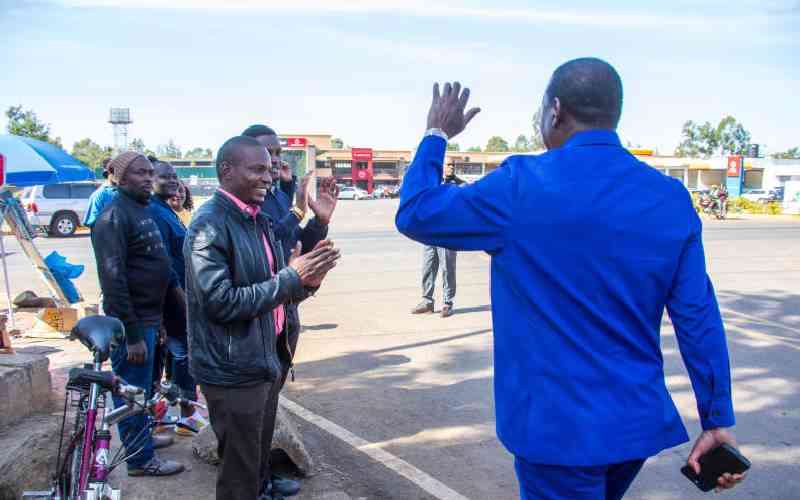By Amos Kareithi
Hosting a visiting president can present a security nightmare for a country. And the situation becomes even trickier when that guest happens to a US president or top official.
But back in the day when global terrorism as we know it today had not yet been defined, the worst that could happen to a high-profile guest touring Africa was to be mauled by lions or gored by an angry buffalo. As such, the hullaballoo that usually accompanies such visits was largely none-existent.
And that is how one resident of Donyo Sambuk, a village in the outskirts of Thika town, got a rare opportunity to host Theodore Roosevelt, who had just completed his seven-year term at the White House.
Although there were no Wikileaks to relay the gripping details of the attendant scandals or reporters to follow up any reports of misdeed by a celebrity, the misadventures of the dignitaries still leaked.
Echoes of Roosevelt’s visit are still heard in parts of the country as it led to an incident where Indian stone carvings that had gone missing and later found were mistaken for Western African gods – Ju and Ja.
Reveals secrets
It is also speculated that it’s this visit that may have birthed the name for one of the fastest growing towns along Thika Road, ‘Juja’.
A new book by Judy Aldrick in her new book, Northrup - The Life of William Northrup McMillan published by Old Africa Books, reveals secrets of his visit, especially what transpired between the American president and McMillian, an American millionaire who pioneered safari tourism.
In the book, Aldrick adds an interesting perspective to this memorable weeklong stay by the 26th president of the US, which almost touched off standoff between Ismailia Muslims and the USA.
The book reconstructs Roosevelt visit to Kenya, where he stayed for seven months.
Roosevelt had come to East Africa in style with all the trappings of power befitting an immediate former head of state and his mission was to hunt. His visit had been sponsored by Andrew Carnergie, and he was expected to collect some samples for the Smithsonian Institute and the American Museum for the Natural History.
The president also intended to write some books from his experiences, which was to take him through Europe, East and Central Africa.
Before sailing to Kenya, Roosevelt had requested McMillan’s assistance through a letter dated August 19, 1908.
“…People who come to East Africa disagree on many points but they are all in unity in saying that you are the best man to help the wandering hunter that there is out there and can do more for him than anyone else,” the letter reads in part.
Stay informed. Subscribe to our newsletter
McMillan was excited by the prospect of hosting the ex-president and responded, “I shall be delighted and make it a point to be here and to place at your disposal any part of my staff of 15 Somalis, Shikaris, Syces and mess boys… I really believe there are no more capable men in Africa.”
Before departing in 1909, Roosevelt’s intended trip was extensively covered by newspapers in his home Louis, which generated a lot of interest.
The expedition was like no other hunting ever undertaken in this part of the continent. When Roosevelt arrived in Mombasa, he was met by the then deputy governor Fredrick Jackson, who in April 1909 held a party for him before escorting him to Nairobi by train.
Although the ex-president was in the country to hunt, his party was one of the biggest and could make a rookie politician green with envy – he had a total of over 500 porters at his beck and call.
As Aldrick recollects, the hunting party was a spectacle to behold. The 500 porters attending to Roosevelt, she reveals, carried all manner of items ranging from collapsible baths to cases of champagne.
The porters at the front of the column flew the American flag as they trailed the animals in the bush, and they would plant it in front of their boss’s sleeping quarters whenever they pitched tent in the jungle. His tent was also equipped with a canvas to protect him from ticks, jiggers and scorpions.
During the trip, the Roosevelt was accompanied by his 20-year-old son, Kermit Roosevelt. Kermit was the third and favourite son and apparently shared his father’s enthusiasm for hunting and love of nature.
Upon arrival in Nairobi, he was received by McMillan, who had made adequate arrangements for his accommodation in his 19,000-acre Juja Estate, which was described by posters as “the finest sporting estate in the world.”
When he was not hunting with his hunting rifles, a magnificent Springfield, Winchester and double barrelled Holland, Roosevelt would while away his at time McMillan’s house near Parklands described as a spacious bungalow.
In the evenings, the former president and his son Kermit would sample the nightlife of Nairobi, with the Norfolk Hotel being their favourite spot.
After an evening of merrymaking at the Norfolk, father and son would pass through Khoja on their way to Parklands, and would amuse themselves further by lingering at the gates of the newly constructed Ismailia Mosque. They are said to have helped themselves to two stone lions, which were at the gate.
“They removed the two stone lions that stood on the gate posts and brought them back to the house and placed them on either side of the fireplace. The stone lions remained there unnoticed for several days,” Aldrick writes.
Incensed Muslims
As Roosevelt enjoyed the lion’s presence in the fireplace, incensed Muslims reported the incident to the police and the matter was picked by the local Press.
Incidentally, a top Government official had seen the two carvings displayed at McMillan’s house in Parklands when he went to pay him a visit.
Upon realising the president and his son had committed a crime – which was now the talk of the town – and had the potential to trigger interreligious tensions, the unidentified official hatched plan to save the dignitaries from being exposed.
McMillan was advised to quietly remove the lions and bury them in his expansive Juja estate to shield his guest from exposure and ridicule.
Long after the president had left the country, and exactly 18 years after his death, the issue of the missing lions resurfaced again. This was in 1937 when Nettlefold family assumed ownership of the Juja estate.
The lions were discovered by the family’s farm workers as they dug up some thorn trees, although at the time it was assumed they were some stone idols from West Africa representing the gods Ju and Ja. This was until the Nairobi Museum identified the items as the stone carvings that had gone missing from the Ismailia Mosque.
Mercifully, by the time the connection between the president and the theft of the lions was made, he was already dead and so was his son, Kermit, who had committed suicide in 1943.
His Kenyan expedition cost more than the inanimate stone objects, as a total of 17 live lions that crossed the ex-president’s path were killed and their bodies carted off to American museums. Roosevelt and his hunting party also killed 11 elephants and 20 rhinos. In total, they trapped or killed more than 11,397 animals, insects and moles, while 262 animals were eaten during the expedition.
On a positive note, specimens of the salted animals which Roosevelt submitted to Smithsonian were preserved for posterity and duplicate animals donated to other American museums. Roosevelt too contributed to knowledge about Kenya’s wildlife by penning his experiences in a book, African Trails-An Account of the African Wanderings of an American Hunter, published in 1910 and which became a bestseller.
The president’s fascination with the lions must have been partly fuelled by his host’s affinity with the felines. At his home in Donyo Sambuk, which was part of Juja estate, McMillan had tamed lions and kept one chained to door.
According to Aldrick, the hunter derived pleasure watching the chained lion feed at his doorstep.
The theatrics by Juja estate’s most famous visitors’ has long been forgotten just as the lions, which roamed around Thika and the plains beyond have disappeared, but the name which to some belongs to West African idols still remains.
 The Standard Group Plc is a
multi-media organization with investments in media platforms spanning newspaper
print operations, television, radio broadcasting, digital and online services. The
Standard Group is recognized as a leading multi-media house in Kenya with a key
influence in matters of national and international interest.
The Standard Group Plc is a
multi-media organization with investments in media platforms spanning newspaper
print operations, television, radio broadcasting, digital and online services. The
Standard Group is recognized as a leading multi-media house in Kenya with a key
influence in matters of national and international interest.
 The Standard Group Plc is a
multi-media organization with investments in media platforms spanning newspaper
print operations, television, radio broadcasting, digital and online services. The
Standard Group is recognized as a leading multi-media house in Kenya with a key
influence in matters of national and international interest.
The Standard Group Plc is a
multi-media organization with investments in media platforms spanning newspaper
print operations, television, radio broadcasting, digital and online services. The
Standard Group is recognized as a leading multi-media house in Kenya with a key
influence in matters of national and international interest.





